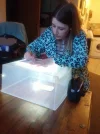In an unusual burst of energy, yesterday I decided to clean out a few drawers. Lo and behold, two of them are filled with slides. For whatever reason, all of the pictures I took during the years I lived in Spain (70-71, 72-73, and 76-77) are slides. I would really love to be able to see them and wonder if any of the forum tech angels would could recommend a way to do it. I would be happy to buy a piece of equipment if that is the best way, but my goal would be to get them on my computer as photos. A little online searching leaves me with a million options and no way to evaluate.
Sorry for this off-camino topic. So I will bring it a little closer to the camino by saying — wouldn’t it be nice to see pictures of Santiago from 1970?!
Sorry for this off-camino topic. So I will bring it a little closer to the camino by saying — wouldn’t it be nice to see pictures of Santiago from 1970?!





















